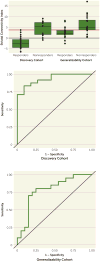Baseline Striatal Functional Connectivity as a Predictor of Response to Antipsychotic Drug Treatment
- PMID: 26315980
- PMCID: PMC4845897
- DOI: 10.1176/appi.ajp.2015.14121571
Baseline Striatal Functional Connectivity as a Predictor of Response to Antipsychotic Drug Treatment
Abstract
Objective: Clinical response to antipsychotic drug treatment is highly variable, yet prognostic biomarkers are lacking. The authors recently demonstrated that successful antipsychotic drug treatment alters resting-state functional connectivity of the striatum. The goal of the present study was to test whether intrinsic striatal connectivity patterns provide prognostic information and can serve as a potential biomarker of treatment response to antipsychotic drugs.
Method: The authors used resting-state functional MRI (fMRI) to develop a prognostic index in a discovery cohort of 41 first-episode schizophrenia patients, then tested this index in an independent cohort of 40 newly hospitalized chronic patients with acute psychosis. In the discovery cohort, patients underwent resting-state fMRI scanning at the initiation of randomized controlled treatment with a second-generation antipsychotic. Whole-brain functional connectivity maps were generated for each subject from striatal seed regions. A stringent measure of clinical response was calculated that required sustained improvement over two consecutive study visits. Clinical response was entered into a survival analysis, and Cox regression was applied to the functional connectivity data. A striatal connectivity index was created, comprising functional connections of the striatum that predicted treatment response. This striatal connectivity index was tested on a generalizability cohort of patients with psychotic disorders who were hospitalized for an acute psychotic episode.
Results: A total of 91 regions functionally connected with the striatum provided significant prognostic information. Connectivity in these regions was used to create a baseline striatal connectivity index that predicted response to antipsychotic treatment with high sensitivity and specificity in both the discovery and generalizability cohorts.
Conclusions: These results provide evidence that individual differences in striatal functional connectivity predict response to antipsychotic drug treatment in acutely psychotic patients. With further development, this has the potential to serve as a prognostic biomarker with clinical utility and to reduce the overall burden associated with psychotic illnesses.
Figures




Comment in
-
Making Progress Toward Individualized Medicine in the Treatment of Psychosis.Am J Psychiatry. 2016 Jan;173(1):5-7. doi: 10.1176/appi.ajp.2016.15101320. Am J Psychiatry. 2016. PMID: 26725338 No abstract available.
Similar articles
-
Antipsychotic treatment and functional connectivity of the striatum in first-episode schizophrenia.JAMA Psychiatry. 2015 Jan;72(1):5-13. doi: 10.1001/jamapsychiatry.2014.1734. JAMA Psychiatry. 2015. PMID: 25372846 Free PMC article. Clinical Trial.
-
Short-term antipsychotic treatment reduces functional connectivity of the striatum in first-episode drug-naïve early-onset schizophrenia.Schizophr Res. 2024 Aug;270:281-288. doi: 10.1016/j.schres.2024.06.016. Epub 2024 Jun 29. Schizophr Res. 2024. PMID: 38944974
-
Altered connectivity between striatal and extrastriatal regions in patients with schizophrenia on maintenance antipsychotics: an [18 F]fallypride PET and functional MRI study.Synapse. 2018 Dec;72(12):e22064. doi: 10.1002/syn.22064. Epub 2018 Aug 24. Synapse. 2018. PMID: 30063263
-
Resting-state functional MRI in treatment-resistant schizophrenia.Front Neuroimaging. 2023 Apr 6;2:1127508. doi: 10.3389/fnimg.2023.1127508. eCollection 2023. Front Neuroimaging. 2023. PMID: 37554635 Free PMC article. Review.
-
Neuroimaging markers of antipsychotic treatment response in schizophrenia: An overview of magnetic resonance imaging studies.Neurobiol Dis. 2019 Nov;131:104209. doi: 10.1016/j.nbd.2018.06.021. Epub 2018 Jun 25. Neurobiol Dis. 2019. PMID: 29953933 Free PMC article. Review.
Cited by
-
Multitask Learning Based Three-Dimensional Striatal Segmentation of MRI: fMRI and PET Objective Assessments.J Magn Reson Imaging. 2021 Nov;54(5):1623-1635. doi: 10.1002/jmri.27682. Epub 2021 May 10. J Magn Reson Imaging. 2021. PMID: 33970510 Free PMC article.
-
Predicting Treatment Response in Schizophrenia With Magnetic Resonance Imaging and Polygenic Risk Score.Front Genet. 2022 Feb 2;13:848205. doi: 10.3389/fgene.2022.848205. eCollection 2022. Front Genet. 2022. PMID: 35186051 Free PMC article.
-
Globally Efficient Brain Organization and Treatment Response in Psychosis: A Connectomic Study of Gyrification.Schizophr Bull. 2016 Nov;42(6):1446-1456. doi: 10.1093/schbul/sbw069. Epub 2016 Jun 28. Schizophr Bull. 2016. PMID: 27352783 Free PMC article.
-
Transdiagnostic Neurobiology of Social Cognition and Individual Variability as Measured by Fractional Amplitude of Low-Frequency Fluctuation in Schizophrenia and Autism Spectrum Disorders.bioRxiv [Preprint]. 2024 Jul 3:2024.07.02.601737. doi: 10.1101/2024.07.02.601737. bioRxiv. 2024. Update in: Biol Psychiatry Cogn Neurosci Neuroimaging. 2025 Apr 21:S2451-9022(25)00132-6. doi: 10.1016/j.bpsc.2025.04.004. PMID: 39005278 Free PMC article. Updated. Preprint.
-
Converging effects of diverse treatment modalities on frontal cortex in schizophrenia: A review of longitudinal functional magnetic resonance imaging studies.J Psychiatr Res. 2017 Jan;84:256-276. doi: 10.1016/j.jpsychires.2016.10.012. Epub 2016 Oct 19. J Psychiatr Res. 2017. PMID: 27776293 Free PMC article. Review.
References
-
- Perälä J, Suvisaari J, Saarni SI, et al. Lifetime prevalence of psychotic and bipolar I disorders in a general population. Arch Gen Psychiatry. 2007;64:19–28. - PubMed
-
- van Os J, Kapur S. Schizophrenia. Lancet. 2009;374:635–645. - PubMed
-
- Laursen TM. Life expectancy among persons with schizophrenia or bipolar affective disorder. Schizophr Res. 2011;131:101–104. - PubMed
-
- Conley RR, Kelly DL. Management of treatment resistance in schizophrenia. Biol Psychiatry. 2001;50:898–911. - PubMed
Publication types
MeSH terms
Substances
Grants and funding
LinkOut - more resources
Full Text Sources
Other Literature Sources
Medical

